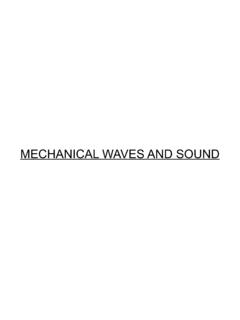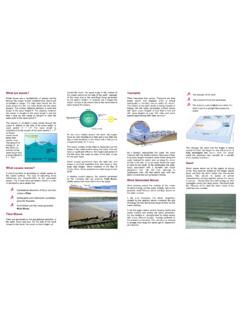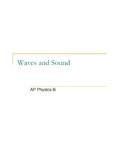Transcription of Chapter 5 Electromagnetic Waves in - MIT OpenCourseWare
1 Chapter 5 Electromagnetic Waves in Plasmas General Treatment of Linear Waves in Anisotropic Medium Start with general approach to Waves in a linear Medium: Maxwell: 1 E B ; ( ) B = oj + c2 t E = t we keep all the medium s response explicit in j. Plasma is (infinite and) uniform so we Fourier analyze in space and time. That is we seek a solution in which all variables go like exp i( t) [real part of] ( ) It is really the linearised equations which we treat this way; if there is some equilibrium field OK but the equations above mean implicitly the perturbations B, E, j, etc. Fourier analyzed: ik B = oj + i c2 E ; ik E = i B ( ) Eliminate B by taking k second eq. and 1st i 2 ik (k E) = oj c2 E ( ) So 2 k (k E) + E + i oj = 0 ( ) 2cNow, in order to get further we must have some relationship between j and E(k, ).
2 This will have to come from solving the plasma equations but for now we can just write the most general linear relationship j and E as j = .E ( ) 96 is the conductivity tensor . Think of this equation as a matrix : jx xx xy .. Ex jy = .. Ey ( ) jz .. zz Ez This is a general form of Ohm s Law. Of course if the plasma (medium) is isotropic (same in all directions) all off diagonal s are zero and one gets j = E. Thus 2 k( ) k2E + E + i o .E = 0 ( ) 2cRecall that in elementary E&M, dielectric media are discussed in terms of a dielectric con stant and a polarization of the medium, P, caused by modification of atoms. Then oE = DPand .D = ext ( ) Displacement Polarization externalcharge and one writes P = oE ( ) susceptibility Our case is completely analogous, except we have chosen to express the response of the medium in terms of current density, j, rather than polarization P For such a dielectric medium, Ampere s law would be written: 1 D B = jext += oE, if jext = 0 , ( ) o t t where the dielectric constant would be = 1 +.
3 Thus, the explicit polarization current can be expressed in the form of an equivalent dielectric expression if E E j + o = .E + = o .E ( ) t t t or = 1 + ( ) i o Notice the dielectric constant is a tensor because of anisotropy. The last two terms come from the RHS of Ampere s law: j + ( oE) . ( ) t If we were thinking in terms of a dielectric medium with no explicit currents, only implicit (in ) we would write this t ( oE); the dielectric constant. Our medium is possibly anisotropic so we need t ( o .E) dielectric tensor. The obvious thing is therefore to define 1 i oc2 = 1 + = 1 + ( ) i o 97 Then k( ) k2E + 2 c2 .E = 0 ( ) and we may regard (k, ) as the dielectric tensor.
4 Write the equation as a tensor multiplying E: = 0 ( ) with D = {kk k21 + 2 c2 } ( ) Again this is a matrix equation 3 simultaneous homogeneous eqs. for E. Dxx Dxy .. Ex = 0 ( ) DEyx .. y .. Dzz Ez In order to have a non zero E solution we must have det D |= 0. ( ) | This will give us an equation relating k and , which tells us about the possible wavelengths and frequencies of Waves in our plasma. Simple Case. Isotropic Medium = 1 ( ) = 1 ( ) Take k in z direction then write out the Dispersion tensor D. 2 k2 0 00 0 0 0 0 2c 2 2c 0 k2D = 0 0 0 0 0 0+ k2 0 0 20 0 kk 0 0 2 ckk k21 2 2c k2 + 2 002c k2 + 2 0= ( ) 02c 2 00 2cTake determinant: 2 2 2 k2 + 2cdet D | =|c = 0.
5 ( ) 2 Two possible types of solution to this dispersion relation: 98 (A) 2 k2 + = 0. ( ) 2c 0 0 0 Ex 0 0 0 E = 0 Ez = 0. ( ) y 0 0 2 Ez2cElectric field is transverse ( = 0) Phase velocity of the wave is c = ( ) k This is just like a regular EM wave traveling in a medium with refractive index kc N = . ( ) (B) 2 = 0 = 0 ( ) 2c Dxx 0 0 Ex 0 D0 yy E = 0 Ex = Ey = 0. ( ) y 0 0 0 Ez Electric Field is Longitudinal (E k = 0) E k. This has no obvious counterpart in optics etc. because is not usually zero. In plasmas = 0 is a relevant solution. Plasmas can support longitudinal Waves . General Case (k in z direction) N2 + xx xy xz 2 2k2c , N2 N2 + D = = ( ) yx yy yz 2 2c zx zz zy When we take determinant we shall get a quadratic in N2 (for given ) provided is not explicitly dependent on k.
6 So for any there are two values of N2 . Two modes . The polarization E of these modes will be in general partly longitudinal and partly transverse. The point: separation into distinct longitudinal and transverse modes is not possible in anisotropic media ( plasma with Bo). All we have said applies to general linear medium (crystal, glass, dielectric, plasma). Now we have to get the correct expression for and hence by analysis of the plasma (fluid) equations. 99 High Frequency Plasma Conductivity We want, now, to calculate the current for given (Fourier) electric field E(k, ), to get the conductivity, . It won t be the same as the DC conductivity which we calculated before (for collisions) because the inertia of the species will be important.
7 In fact, provided ei ( ) we can ignore collisions altogether. Do this for simplicity, although this approach can be generalized. Also, under many circumstances we can ignore the pressure force p. In general will be true if vte,i We take the plasma equilibrium to be at rest: vo = 0. This gives a k manageable problem with wide applicability. Approximations: Collisionless ei = 0 Cold Plasma p = 0 ( T 0) ( ) Stationary Equil vo = 0 Zero B field case To start with take Bo = 0: Plasma isotropic Momentum equation (for electrons first) v mn + (v. )v = nqE ( ) t Notice the characteristic of the cold plasma approx. that we can cancel n from this equation and on linearizing get essentially the single particle equation. v1 m = qE (Drop the 1 suffix now).
8 ( ) t This can be solved for given as q v = E ( ) i m and the current (due to this species, electrons) is 2nqj = nqv = E ( ) i m So the conductivity is 2nq = i ( ) m Hence dielectric constant is i nq2 1 = 1 + = 1 = 1 + ( ) o m o 2 100 Longitudinal Waves (Bo = 0) Dispersion relation we know is 2nq1 = 0 = 1 ( ) m o 2 [Strictly, the we want here is the total including both electron and ion contributions to the conductivity. But e i mi me (for z = 1) ( ) so to a first approximation, ignore ion motions.] Solution 2 = neq2 e . ( ) omeIn this approx. longitudinal oscillations of the electron fluid have a single unique frequency: 1 22nee p = ( ) . me o This is called the Plasma Frequency (more properly pe the electron plasma frequency).
9 If we allow for ion motions we get an ion conductivity iniq2 i = i ( ) mi and hence 2 i tot = 1 + i ( e + i) = 1 neqe 2 + niq1 ( ) o ome omi 2 = 1 2 + 2 / 2 pe pi where 1 22niq pi i ( ) omi is the Ion Plasma Frequency . Simple Derivation of Plasma Oscillations Take ions stationary; perturb a slab of plasma by shifting electrons a distance x. Charge built up is neqx per unit area. Hence electric field generated E = neqex o ( ) 101 1 2 Figure : Slab derivation of plasma oscillations Equation of motion of electrons dv neq2xe me = ; ( ) dt o 2d2xneq+ e x = 0 ( ) dt2 ome Simple harmonic oscillator with frequency 2neq pe = e Plasma Frequency. ( ) ome The Characteristic Frequency of Longitudinal Oscillations in a plasma.
10 Notice 1. = p for all k in this approx. 2. Phase velocity can have any value. k 3. Group velocity of wave, which is the velocity at which information/energy travel is d vg = = 0 !! ( ) dk In a way, these oscillations can hardly be thought of as a proper wave because they do not transport energy or information. (In Cold Plasma Limit). [Nevertheless they do emerge from the wave analysis and with less restrictive approxs do have finite vg .] Transverse Waves (Bo = 0) Dispersion relation: 2 k2 + = 0 ( ) c2 102 or 2 k2cN 2 = = 1 2 + 2 / 2 pe pi 2 1 2 ( ) pe/ 2 Figure : Unmagnetized plasma transverse wave. Figure : Alternative dispersion plot. Alternative expression: 2 2 k2 + = 0 ( ) 2c2 cp 103 which implies 2 2 2 = 2 + k c ( ) p 2 2 = 2 + k c.



















